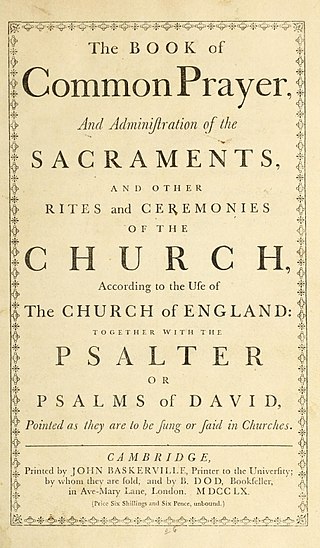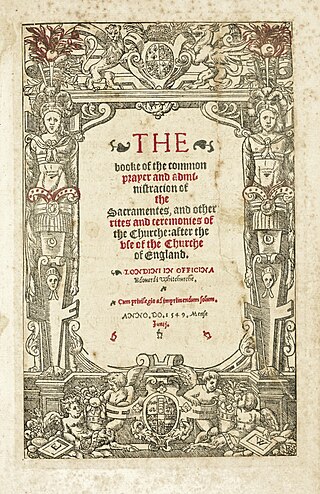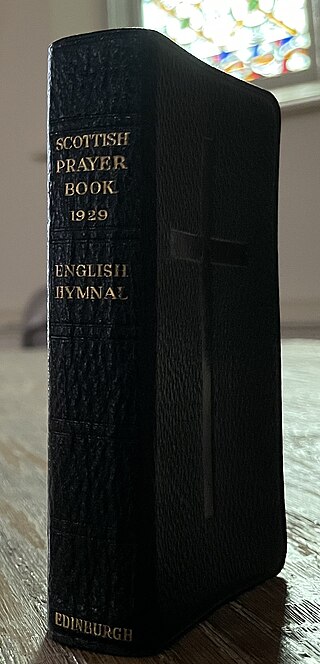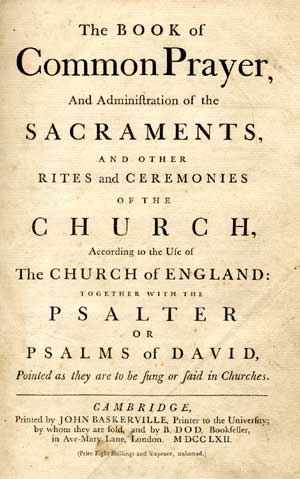
The Book of Common Prayer (BCP) is the name given to a number of related prayer books used in the Anglican Communion and by other Christian churches historically related to Anglicanism. The first prayer book, published in 1549 in the reign of King Edward VI of England, was a product of the English Reformation following the break with Rome. The work of 1549 was the first prayer book to include the complete forms of service for daily and Sunday worship in English. It contained Morning Prayer, Evening Prayer, the Litany, and Holy Communion and also the occasional services in full: the orders for Baptism, Confirmation, Marriage, "prayers to be said with the sick", and a funeral service. It also set out in full the "propers" : the introits, collects, and epistle and gospel readings for the Sunday service of Holy Communion. Old Testament and New Testament readings for daily prayer were specified in tabular format as were the Psalms and canticles, mostly biblical, that were provided to be said or sung between the readings.

The Elizabethan Religious Settlement is the name given to the religious and political arrangements made for England during the reign of Elizabeth I (1558–1603). The settlement, implemented from 1559 to 1563, marked the end of the English Reformation. It permanently shaped the Church of England's doctrine and liturgy, laying the foundation for the unique identity of Anglicanism.

Anglican church music is music that is written for Christian worship in Anglican religious services, forming part of the liturgy. It mostly consists of pieces written to be sung by a church choir, which may sing a cappella or accompanied by an organ.
Christian liturgy is a pattern for worship used by a Christian congregation or denomination on a regular basis. The term liturgy comes from Greek and means "public work". Within Christianity, liturgies descending from the same region, denomination, or culture are described as ritual families.
The Anglican Church of Southern Africa, known until 2006 as the Church of the Province of Southern Africa, is the province of the Anglican Communion in the southern part of Africa. The church has twenty-five dioceses, of which twenty-one are located in South Africa, and one each in Eswatini, Lesotho, Namibia and Saint Helena. In South Africa, there are between 3 and 4 million Anglicans out of an estimated population of 45 million.

The Spanish Reformed Episcopal Church, also translated as Reformed Episcopal Church of Spain, or IERE is the church of the Anglican Communion in Spain. It was founded in 1880 and since 1980 has been an extra-provincial church under the metropolitan authority of the Archbishop of Canterbury. Its cathedral is the Anglican Cathedral of the Redeemer in Madrid.

The 1928 Book of Common Prayer, sometimes known as the Deposited Book, is a liturgical book which was proposed as a revised version of the Church of England's 1662 Book of Common Prayer. Opposing what they saw as an Anglo-Catholic revision that would align the Church of England with the Catholic Church—particularly through expanding the practice of the reserved sacrament—Protestant evangelicals and nonconformists in Parliament put up significant resistance, driving what became known as the Prayer Book Crisis.
A use, also commonly usage and recension, within Christian liturgy is a set of particular texts or customs distinct from other practitioners of a broader liturgical ritual family, typically on the basis of locality or religious order. Especially prevalent within the Latin liturgical rites of the Middle Ages, few significant uses persisted following a general suppression of these variations by Pope Pius V in the 16th century. The word "use" is most commonly applied to distinct practices branching from the Roman Rite, though it and "recension" can be applied in variations of other ritual families, such as the to Ruthenian recension of the Byzantine Rite and Maronite Use of the West Syriac Rite. In the historic context of the Scottish Episcopal Church, "usage" refers to certain aspects of the Eucharistic liturgy valued by some nonjurors.

The 1549 Book of Common Prayer (BCP) is the original version of the Book of Common Prayer, variations of which are still in use as the official liturgical book of the Church of England and other Anglican churches. Written during the English Reformation, the prayer book was largely the work of Thomas Cranmer, who borrowed from a large number of other sources. Evidence of Cranmer's Protestant theology can be seen throughout the book; however, the services maintain the traditional forms and sacramental language inherited from medieval Catholic liturgies. Criticised by Protestants for being too traditional, it was replaced by the significantly revised 1552 Book of Common Prayer.

The 1979 Book of Common Prayer is the official primary liturgical book of the U.S.-based Episcopal Church. An edition in the same tradition as other versions of the Book of Common Prayer used by the churches within the Anglican Communion and Anglicanism generally, it contains both the forms of the Eucharistic liturgy and the Daily Office, as well as additional public liturgies and personal devotions. It is the fourth major revision of the Book of Common Prayer adopted by the Episcopal Church, and succeeded the 1928 edition. The 1979 Book of Common Prayer has been translated into multiple languages and is considered a representative production of the 20th-century Liturgical Movement.

The 1929 Scottish Prayer Book is an official liturgical book of the Scotland-based Scottish Episcopal Church. The 1929 edition follows from the same tradition of other versions of the Book of Common Prayer used by the churches within the Anglican Communion and Anglicanism generally, with the unique liturgical tradition of Scottish Anglicanism. It contains both the forms of the Eucharistic liturgy and Daily Office, as well as additional public liturgies and personal devotions. The second major revision of the Book of Common Prayer following the full independence of the Scottish Episcopal Church, the 1929 Scottish Prayer Book succeeded the 1912 edition and was intended to serve alongside the Church of England's 1662 prayer book.

The 1962 Book of Common Prayer is an authorized liturgical book of the Canada-based Anglican Church of Canada. The 1962 prayer book is often also considered the 1959 prayer book, in reference to the year the revision was first approved for an "indefinite period" of use beginning in 1960. The 1962 edition follows from the same tradition of other versions of the Book of Common Prayer used by the churches within the Anglican Communion and Anglicanism generally. It contains both the Eucharistic liturgy and Daily Office, as well as additional public liturgies and personal devotions. The second major revision of the Book of Common Prayer of the Anglican Church of Canada, the 1962 Book of Common Prayer succeeded the 1918 edition, which itself had replaced the Church of England's 1662 prayer book. While supplanted by the 1985 Book of Alternative Services as the Anglican Church of Canada's primary Sunday service book, the 1962 prayer book continues to see usage.

The 1662 Book of Common Prayer is an authorised liturgical book of the Church of England and other Anglican bodies around the world. In continuous print and regular use for over 360 years, the 1662 prayer book is the basis for numerous other editions of the Book of Common Prayer and other liturgical texts. Noted for both its devotional and literary quality, the 1662 prayer book has influenced the English language, with its use alongside the King James Version of the Bible contributing to an increase in literacy from the 16th to the 20th century.
An ordinal, in a modern context, is a liturgical book that contains the rites and prayers for the ordination and consecration to the Holy Orders of deacons, priests, and bishops in multiple Christian denominations, especially the Edwardine Ordinals within Anglicanism. The term "ordinal" has been applied to the prayers and ceremonies for ordinations in the Catholic Church, where the pontificals of the Latin liturgical rites typically compile them along with other liturgies exclusive to bishops. In medieval liturgies, ordinals supplied instruction on how to use the various books necessary to celebrate a liturgy and added rubrical direction.

The Edwardine Ordinals are two ordinals primarily written by Thomas Cranmer as influenced by Martin Bucer and first published under Edward VI, the first in 1550 and the second in 1552, for the Church of England. Both liturgical books were intended to replace the ordination liturgies contained within medieval pontificals in use before the English Reformation.

The 1637 Book of Common Prayer, commonly known as the Scottish Prayer Book or Scottish liturgy, was a version of the English Book of Common Prayer revised for use by the Church of Scotland. The 1637 prayer book shared much with the 1549 English prayer book—rather than the later, more reformed English revisions—and contained Laudian liturgical preferences with some concessions to a Scottish and Presbyterian audience. Charles I, as King of Scotland and England had wished to impose the liturgical book to align Scottish worship with that of the Church of England. However, after a coordinated series of protests—including the legendary opposition by Jenny Geddes at St Giles' Cathedral—the 1637 prayer book was rejected.
A sentence, particularly in Anglican services, is a short passage from the Bible that is recited in Christian liturgies. For example, with the Church of England's currently authorized 1662 Book of Common Prayer, sentences are used at several points within different rites: prescribed sentences are to be recited before Morning and Evening Prayers, at least one sentence may be said or sung during the Holy Communion office offertory, and sentences appear at multiple points during the burial service.

Free and Candid Disquisitions is a 1749 pamphlet written and compiled by John Jones, a Welsh Church of England clergyman, and published anonymously. The text advocated for reforming the Church of England to enable the reintegration of independent English Protestants, particularly through changes to the liturgies of the mandated 1662 prayer book.
Geoffrey John Cuming was a Church of England clergyman, liturgist, and music historian. After being permanently injured during his British Army service prior to the Battle of Arnhem, Cuming was ordained a priest and wrote several historical texts. He was an editor of the 1952 World's Encyclopedia of Recorded Music, a major discography. On Christian liturgy, Cuming's work included The Durham Book on John Cosin's proposed liturgy and A History of Anglican Liturgy. His works on Early Christian liturgies included collaboration with Ronald Jasper and a posthumously published text on the Liturgy of Saint Mark. Cuming was an advisor to the Church of England's committees charged with producing new liturgical texts which produced the Alternative Service series, Alternative Service Book, and Common Worship. He also served as an editorial secretary for the Alcuin Club, vice-principal at St John's College, Durham, and on the faculty of both Ripon College Cuddesdon and the Church Divinity School of the Pacific.
Karen B. Westerfield Tucker is an American historian and United Methodist minister. She has authored several histories, including some on Christian liturgy which were published in The Oxford Guide to the Book of Common Prayer and The Oxford History of Christian Worship; she also edited the latter volume with Geoffrey Wainwright. Westerfield Tucker was the president of the ecumenical liturgiological organization Societas Liturgica and was the editor-in-chief of its journal, Studia Liturgica. She is the Professor of Worship at the Boston University School of Theology.














